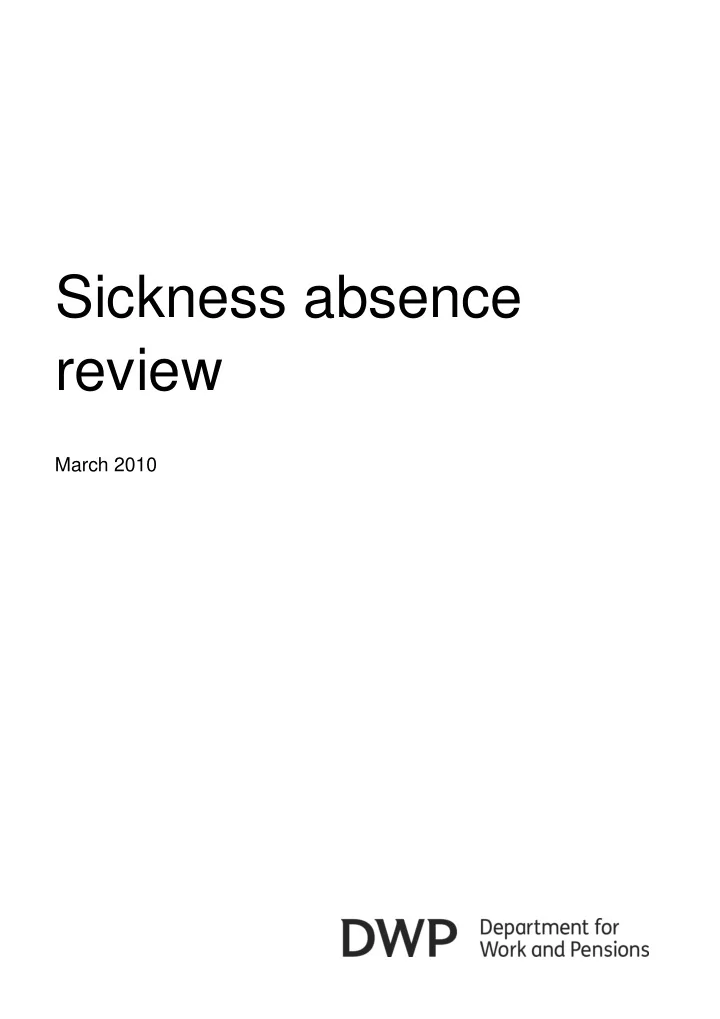

Sickness absence review March 2010
Sickness absence review Sickness absence review Current position Short-term absence Each year around 150m working days are lost to sickness absence. Much of this absence is short-term… Long-term absence …though a significant proportion – upwards of a ¼ – is longer-term and can lead to people falling out of work. Worklessness Around 300,000 people each year move from work to Employment and Support Allowance or Incapacity Benefit. Where do the costs of sickness absence and ill-health fall? State Worklessness benefits; foregone taxes; extra healthcare Employers Statutory Sick Pay / Occupational Sick Pay; costs of staff turnover; time spend managing absence; occupational health where offered Individuals Loss of income; emotional and physical costs of ill-health Independent review of sickness absence The scope of the review is to: • explore how the current sickness absence system could be changed to help people stay in work and reduce overall costs; • examine whether the balance of these costs are appropriately shared between the State, individuals and employers, and • make tangible recommendations for system change.
Sickness absence review The current journey Incentives to rehabilitate and retain individuals in work lies with employers . Employers pay sick pay and some offer rehabilitation and occupational health support. GPs also play a crucial role. GPs provide sickness certification and are typically the first healthcare professionals that people encounter when off sick from work. The state’s main interventions are focused on the after job-loss period. The state defines levels and duration of SSP and controls the benefit system. Those flowing from work to ESA typically: • Have lower skills; • Are lower paid; • Suffer from mental health or musculoskeletal disorders, and; • Are more likely to have been working in a small or medium-sized enterprise. Yet a health condition need not necessarily prevent someone from working 27.3 million employed • 26 percent with a health condition or disability • 650,000 off sick 9 million inactive • 48% with a health condition or disability 2.4 million unemployed • 29% with a health condition or disability Key questions Question for individuals • Why do some people with a certain health condition work while others with the same condition do not?
Sickness absence review • How much sickness absence is driven by sick pay incentives? • In what circumstances do individuals exit work to flow on to ESA and how many would have preferred to stay in work? • If flows on to ESA are reduced, what is the impact on other groups in the labour market (for example those trying to enter the labour market from unemployment or education)? Questions for employers • What drives the differences in sickness absence rates between larger and smaller companies, between public and private sectors and different industries? • In what circumstances does ill-health lead to an employer wanting an individual to exit employment? How much overlap is there between exits for ill-health and exits for under-performance? • What are employers’ main concerns in this area – is it the cost of sickness, of rehabilitation or problems around dismissals? Questions for health professionals • What drives sickness certification behaviour? • Does this vary between physical and mental health conditions? • How effective is occupational health in facilitating returns to work? How could occupational health be improved? Questions about international evidence • Which countries, if any, have a more efficient (less costly) sickness absence system? • What are the labour market impacts of placing relatively more responsibility for sickness and disability on employers? • Why do some countries rely on private, rather than state, insurance for sickness and disability and what are the pros and cons of this? Timetable 17 February – Review announced. Two stages of the review: Stage 1 (Feb – May): Evidence gathering and analysis Stage 2 (May – Aug): Policy focus Publication in late summer 2011
Sickness absence review Next steps We want to hear your views: Now, in the evidence gathering stage, to: • Test that our key questions are right; • Check for any gaps – what other things should we consider, and; • To suggest other sources of information we can use. And later, in the policy phase: • To examine the emerging options How to contact us Please do contact us by email at: sickness.absencereview@dwp.gsi.gov.uk or in writing: Independent Sickness Absence Review 6A Caxton House Tothill Street London SW1H 9NA We will keep in touch with you as the review progresses.
Recommend
More recommend